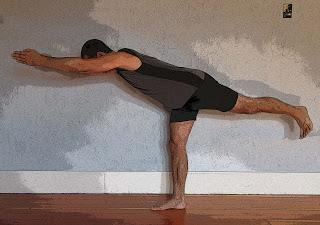Science reporter William Broad, who a year ago woke the proverbial sleeping (downward facing) dog of the yoga world with his NY Times Magazine article How Yoga Can Wreck Your Body, is back at it. This time he's claiming—based on a review of injury statistics—that men are at much greater risk of serious injury from yoga (see Wounded Warrior Pose). The claim may or may not be true, but I don’t think you can really tell from the data he presents. I plan on writing more about this topic in my next email newsletter, but wanted to respond to Nina's query for the blog today.
Man in Unwounded Warrior 3 Pose by Nina Zolotow
As Broad makes clear in his book, The Science of Yoga (from which the first Times yoga article was excerpted), the subject of his inquiry is the physical practice of yoga as found in most classes. He’s not talking about meditation, chanting, selfless service or spiritual development. Even so, styles of asana practice, different teachers and classes vary enormously. It’s my feeling that Broad's failure to account for these differences could entirely explain his findings.Back when I was taking a lot of classes of different styles (which I'm not doing anymore, so if things have changed I’d love to get feedback from readers), I found that in the more meditative and restorative classes, I was often one of the only males in the room. But in some of the more vigorous and acrobatic classes, the gender split was closer to even. Thus, men having a higher incidence of yoga injuries could simply be a reflection of their favoring the kinds of classes where injuries seem more common, and not actually reflect any greater vulnerability to injury.
It is also my experience (and that of most yoga teachers I’ve spoken with) that people who are more flexible are generally at greater risk of injury, particularly for injuries like hamstring muscle tears, and overstretching of the ligaments. It varies from person to person obviously, but on average men are much stiffer than women, and seemingly less prone to these types of injuries.
Many yoga injuries—again based on my experience, since we lack data—happen when people are trying too hard to achieve a particular result. Your foot won’t go into Lotus pose, for example, so you pull a little harder to get it into position, and in the process tear ligaments in your knee. But before that happens, the body almost always gives warning signs, such as pain or strained breathing. If you decide to ignore them and power your way through, problems may result. Both men and women can do this, but if I had to guess I’d say men are more likely to, so in this way may be at higher risk.
William Broad loves to create controversy. Beyond claiming that yoga can wreck your body, he has also written that yoga can make you fat, and that the entire practice started out as a sex cult (neither of which is true). Statistically speaking, if Broad’s analysis is correct (and given the methodological problems in how he did his analysis—see Is Yoga Really Dangerous for Men? Dr. Ram Rao Weighs In—I don't think we can know), men may indeed be at higher risk of injuries when practicing asana, but this may miss a larger truth. My guess is that if a man practices less demanding forms of yoga, or any style of yoga in a less aggressive and more mindful way, that his risk probably isn’t any greater than that of a woman, and may even be less. Uh oh, there’s a potential future headline for Mr. Broad: Women at Greater Risk of Yoga Injuries! You heard it here first….
Subscribe to YOGA FOR HEALTHY AGING by Email ° Follow Yoga for Healthy Aging on Facebook

